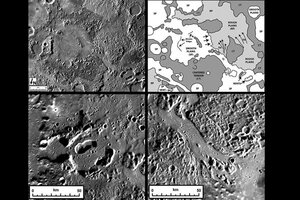Messenger's message from Mercury: Time to rewrite the textbooks
Scientists with the Messenger mission to Mercury unveiled their findings Thursday, which are answering some decades-old mysteries – but also creating new ones.

These images from the Messenger spacecraft show candidates for ancient lava flows and vents on Mercury. At upper left and right, the image and sketch map show volcanic flow-related features. At lower left, the pits could be source vents. At lower right, the teardrop-shaped hills could have been shaped by lava erosion.
AAAS/Science
The Messenger spacecraft has already begun to rewrite textbooks about Mercury only six months after it settled into orbit around the first planet from the sun.
Its findings, presented at a press conference Thursday, challenge prevailing theories on planetary formation and paint a picture of a planet long ago convulsed by massive lava flows.
As the least studied of the solar system's four inner planets, Mercury is ready for a scientific facelift. But the relative dearth of information about it means that scientists are struggling to make sense of everything Messenger is telling them. For now, the data are raising more questions than answers. But 36 years after humanity's only other visits to Mercury – two Mariner 10 flybys in 1974 and 1975 – scientists are at least learning which questions to ask.
"Mercury is not the planet described in the textbooks," said James Head III, a mission team member and geologist at Brown University in Providence, R.I.
In Messenger's first months orbiting Mercury, the mission has focused on the questions raised by Mariner 10 decades ago.
Foremost among them was Mercury's curious construction. The iron core of Mercury is much larger relative to the planet's total size than the cores of any other inner planet – Venus, Earth, or Mars.
Since Mariner 10's flybys, several theories emerged as to why this could be. Perhaps Mercury was once two to three times bigger and much of its outer surface was blown away by the intensity of the sun. Or perhaps the outer surface of a once-larger was removed in a cataclysmic collision.
Messenger, it seems, has ruled out every theory – except one: the theory of enstatitic chondritic composition. Mercury might have formed through the accretion of metal-rich space rocks called chondrite – one of the leftovers from the formation of the solar system. Some 86 percent of all meteorites that are seen as they fall to Earth and are collected are made of chondrite, though only 2 percent of those are enstatite chondrites, the metal-rich form thought to be involved in Mercury's formation.
The reason this is the last theory standing is Messenger's surprising detection of elements such as potassium and sulfur. Solar siphoning or a cosmic collision would have generated tremendous heat on Mercury, burning off these volatile elements. Their continuing presence on Mercury means that such a heat-intense episode could never have happened.
The problem with the theory of enstatitic chondritic composition, however, is that it raises questions about the other inner planets, which do not appear to have formed this way.
"Its an open question as to why Mercury looks so much like chondritic material, while Earth does not," says Patrick Peplowski, a staff scientist at the Johns Hopkins University Applied Physics Lab, which is running the mission.
A second Mariner-era mystery was the apparent lack of obvious vulcanism in Mercury's distant past. Unlike the moon, which shows clear evidence of ancient vulcanism with its dark plains called maria, Mercury is widely pitted by craters and lacking obvious surface features that suggest lava flows once repaved the surface.
This is important because vulcanism is seen as being integral to planetary dynamics. Dr. Head called it "the pulse of a planet."
Sure enough, six months at Mercury provided the closer look that scientists sought. They found relatively smooth plains in the northern high latitudes, covering about 6 percent of the planet's total surface area.
What they did not find, was clear evidence of volcanoes. Notably absent were the huge bulges in the landscape that characterize shield volcanoes – the sort of volcanoes present on the Big Island of Hawaii and littered across the Martian surface.
The apparent answer: gashes on the surface of Mercury that poured out lava in huge events were later covered by that lava, making them impossible to see from orbit. Still, scientists have found likely candidates for lava vents and the lava flows that came from them.
Scientists also have learned a little more about why Mercury's craters look brighter and bluer than others around the solar system. Photos have shown that crater floors are fretted with what the mission team calls "hollows" – small, irregular-shaped depressions that look like honeycombs.
The scientists are not sure what causes the hollows – which could still be forming across Mercury – but suggest that some material might become unstable when exposed to the surface, leaving the small pits behind.
"We're making fundamental new discoveries," said Head.
